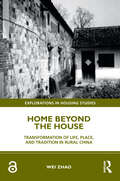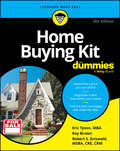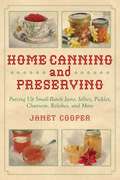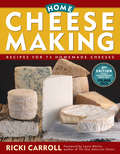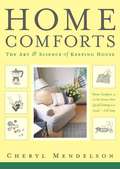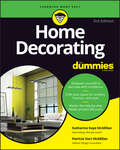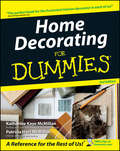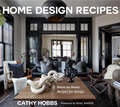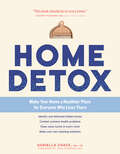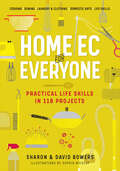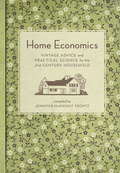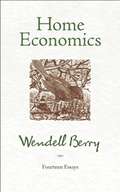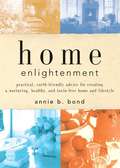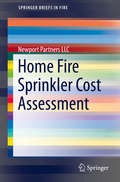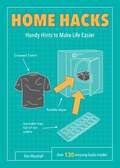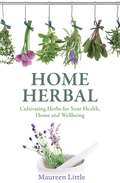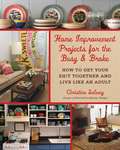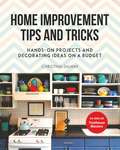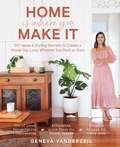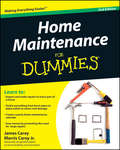- Table View
- List View
Home Beyond the House: Transformation of Life, Place, and Tradition in Rural China (Explorations in Housing Studies)
by Wei ZhaoBased on extended fieldwork conducted between 2007 and 2019, this book aims to answer a simple question: What is the meaning of home for people living in vernacular settlements in rural China? This question is particularly potent since rural China has experienced rapid and fundamental changes in the twenty-first century under the influences of national policies such as "Building a New Socialist Countryside" enacted in 2006 and "Rural Revitalization" announced in 2018. Drawing upon ethnographic fieldwork, building surveys, archival research, and over 600 photographs taken by residents along with their life stories, this book uncovers the meanings of home from rural residents’ perspectives, who belong to a social group that is underrepresented in scholarship and underserved in modern China. In other words, this study empowers rural residents by giving them voice. This book links the concepts of place, home, and tradition into an overarching argument: The meaning of home rests on the ideas of tradition, including identity, consanguinity, collectivity, social relations, land ownership, and rural lifestyle.
Home Buying Kit For Dummies
by Eric Tyson Ray Brown Robert S. GriswoldThe top choice among home buyers in need of assistance Home Buying Kit For Dummies is your one-stop guide to navigating the housing market and buying a home. This updated book helps you through the largest—and most complex—purchase you're likely to make, offering a map to navigating the occasionally choppy waters of home buying. Get insight on evaluating your financial readiness to buy a house, securing a mortgage, building a team of advisors, negotiating a deal, and getting your new home ready after you buy. A small investment in know-how will make a big difference, making every step of the home buying process smoother. Understand interest rates and determine your budget for buying a new home Learn how to get approved for a mortgage and recognize fair house prices Get a real estate agent and find the home that fits your needs Survive the inspection and appraisal stage, then seal the deal This book is a perfect choice for first-time and inexperienced home buyers who need advice on the steps in buying a home.
Home Buying for Dummies (2nd edition)
by Ray B. Browne Eric TysonEasy-to-follow information on buying a home.
Home Canning and Preserving: Putting Up Small-Batch Jams, Jellies, Pickles, Chutneys, Relishes, and More
by Janet CooperHome Canning and Preserving instructs readers how to make small-batch preserves, pickles, and more, whether in the summer or winter months, even when fresh produce is not as readily available. Janet Cooper, who has spent a lifetime finessing the art of small-batch preserving, provides you with step-by-step instructions on how to put by some of your favorite canned and jarred goods. With color photographs and one hundred recipes, including orange marmalade, fig jam, six-fruit chutney, apple sauce, green tomato relish, and hot mustard, this is the definitive guide-and the perfect gift-for gardeners and home cooks.Skyhorse Publishing, along with our Good Books and Arcade imprints, is proud to publish a broad range of cookbooks, including books on juicing, grilling, baking, frying, home brewing and winemaking, slow cookers, and cast iron cooking. We’ve been successful with books on gluten-free cooking, vegetarian and vegan cooking, paleo, raw foods, and more. Our list includes French cooking, Swedish cooking, Austrian and German cooking, Cajun cooking, as well as books on jerky, canning and preserving, peanut butter, meatballs, oil and vinegar, bone broth, and more. While not every title we publish becomes a New York Times bestseller or a national bestseller, we are committed to books on subjects that are sometimes overlooked and to authors whose work might not otherwise find a home.
Home Cheese Making: Recipes for 75 Delicious Cheeses
by Ricki CarrollIn this home cheese making primer, Ricki Carrol presents basic techniques that will have you whipping up delicious cheeses of every variety in no time. Step-by-step instructions for farmhouse cheddar, gouda, mascarpone, and more are accompanied by inspiring profiles of home cheese makers. With additional tips on storing, serving, and enjoying your homemade cheeses, Home Cheese Making provides everything you need to know to make your favorite cheeses right in your own kitchen.
Home Comforts: The Art and Science of Keeping House
by Cheryl MendelsonA classic bestselling resource for every household, Home Comforts helps you manage everyday chores, find creative solutions to domestic dilemmas, and enhance the experience of life at home. &“Home Comforts is to the house what Joy of Cooking is to food.&” —USA TODAYHome Comforts is an engaging and comprehensive book about housekeeping. It is a lively and readable guide for both beginners and experts in all the domestic arts. From keeping surfaces free of germs, watering plants, removing stains, folding a fitted sheet, cleaning china, tuning a piano, lighting a fire, setting the dining room table—this guide covers everything that people might want to do for themselves in their homes. Further topics include: making up a bed with hospital corners, expert recommendations for safe food storage, reading care labels (and sometimes carefully disregarding them), keeping your home free of dust mites and other allergens, this is a practical, good-humored, philosophical guidebook to the art and science of household management.
Home Decor Cheat Sheets: Need-to-Know Stuff for Stylish Living
by Jessica ProbusTHE MOST IMPORTANT CONCEPTS OF HOME DESIGN, DECOR, AND FURNISHING SIMPLIFIED INTO 300 FRIENDLY, EASTY-TO-UNDERSTAND GRAPHICSHome Decor Cheat Sheets shows you the dos, the don&’ts and the timeless design rules for a perfectly coordinated space. These colorful, easy-to-understand illustrations teaching you everything needed to beautifully furnish, arrange and decorate your home. In mere seconds, you&’re able to grasp the vital concepts needed to give your house an inspiring look, including how to:• Properly Match Furniture Styles• Brighten Rooms with Natural Light• Stylishly Arrange Wall Art• Perfectly Fit the Rug to the Room• Create Dramatic Lighting Effects• Add Elegance Using Throw Pillows
Home Decorating For Dummies (General Trade Ser. #178)
by Katharine Kaye McMillan Patricia Hart McMillanWant to be your own decorator? Design on a dime with Dummies! Home Decorating For Dummies packs all the information you need to know about décor into one easy-to-read source. Whether you want to decorate one room or make over the whole house, this book has everything you need to design like a pro. This is the only reference you&’ll need to transform your home into a space you&’ll love. Dummies offers no-nonsense help, so you can plan perfect projects and stay within budget. Updated with the latest on smart homes, short-term rentals, DIY décor, and more. Learn how to optimize your home&’s floor plan Discover tricks for mixing patterns, colors, and textures successfully Refresh your home&’s style without spending a fortune Decorate rental properties with eye-catching, trendy style Untangle the terms—mid-century modern, farmhouse, minimalism—and pinpoint your design styleFor those seeking ideas, resources, and budget-wise tips to spark their decorating creativity, Home Decorating For Dummies is a must-have.
Home Decorating For Dummies, 2nd Edition
by Katharine Kaye Mcmillan Patricia Hart McmillanDo you long to create picture-perfect rooms but can't quite seem to achieve them? Do you want better functioning spaces for working, playing, or living? Do you clamor to express your personal style? If you said "yes" to any of these questions, you've turned to the right source for real answers from the pros. Home Decorating For Dummies, 2nd Edition is for all kinds of people in all kinds of decorating situations, including: First-time buyers or renters. You have a whole new place to decorate. Where do you start? Second- or third-time home buyers. Whether you've gone up or down in size, stayed in the same region or moved to a whole new one, you need to know how to make your old furniture work in a new setting, how to add furnishings, and how to make your style seem fresh. Newly blended families. He has furniture, she has furniture, they have furniture. Can it all work together harmoniously? Indeed! And anyone else who loves decorating. Don't forget: Imagination counts. Each part of Home Decorating For Dummies, deals with a broad area of decorating, and each chapter contains specific and detailed information. You'll discover tips on Basic planning - where to begin when you want to start decorating Creating surface interest - the effects of color, pattern, and texture, and the problems created by too much or too little of them Creating backgrounds - what you need to know about the special decorating requirements of your walls Tackling tough rooms - how to effectively decorate rooms that have special functional requirements Accessorizing with art and other stuff - adding the final flourishes to every space in your place Home Decorating For Dummies, 2nd Edition contains all the basics - including how to figure out what you can spend; how to spend it; and the latest and greatest in styles, trends, and technology. What do you do with your space next? The possibilities are endless.
Home Design Recipes: Room by Room Recipes for Design
by Cathy HobbsWelcome to the world of Home Design Recipes – your ultimate guide to modern home design rooms with ease. Just as baking the perfect cake requires sourcing the finest ingredients and following a tried-and-true recipe, designing a stunning space demands the right "ingredients" and a step-by-step plan.Simple home improvement. In this innovative design "cookbook," we demystify the process of interior design, providing you with easy-to-follow recipes for crafting modern, stylish homes. Gone are the days of merely admiring beautiful pictures without understanding how to replicate the look. With Home Design Recipes, you'll be empowered to transform your house design from ordinary to extraordinary. Endless design ideas. Each recipe in this book is meticulously crafted to guide you through the modern home design process, from A to Z. Cathy Hobbs covers essential topics, popular hacks, and trade secrets, offering practical advice and top tips for every step of the journey. Whether you're a seasoned design enthusiast or a DIY newcomer, you'll find inspiration and guidance to elevate your house design. Inside this book, you&’ll find: A go-to resource for all things modern home design A house decorating book that equips you with the knowledge and confidence to create your dream home The courage and confidence to unleash your creativity and design a home that reflects your unique style If you liked The Art of Home, Call It Home, or The New Design Rules, you&’ll love Home Design Recipes.
Home Detox: Make Your Home a Healthier Place for Everyone Who Lives There
by Daniella ChaceFrom cleaning products to mattresses, furniture, food storage materials, and more, our homes are filled with hidden toxins that can contribute to chronic health conditions. Professional toxicologist and health writer Daniella Chace offers an enlightening and accessible room-by-room guide to identifying and removing potentially toxic items, along with suggestions for safe, affordable alternatives.
Home Ec for Everyone: Cooking · Sewing · Laundry & Clothing · Domestic Arts · Life Skills
by David Bowers Sharon BowersDid you remember your scissors?Discover the tremendous pleasure of learning how to do it yourself how to cook, sew, clean, and more, the way it used to be taught in Home Ec class. With illustrated step by step instructions, plus relevant charts, lists, and handy graphics, Home Ec for everyone offers a crash course in learning 118 practical life skills-everything from frosting the perfect birthday cake to fixing a zipper to whitening a dingy T-shirt to packing a suitcase (the right way). It&’s all made clear in plain, nontechnical language for any level of DIYer, and it comes with a guarantee: No matter how simple the task, doing it with your own two hands provides a feeling of accomplishment that no app or device will ever give you.
Home Economics
by Jennifer Mcknight Trontz"Housekeeping is becoming more and more a matter of science, and the laurels are bound to fall to the woman who conducts her household in a business-like way." Let the thrifty sensibility of yesteryear be your guide as you shop for the most economical foods, choose wall colors scientifically, clean with natural products, look your best without breaking the bank, and budget your way to frugal efficiency. In this amazing collection of clever wisdom and practical advice drawn from vintage home-economics textbooks, you'll find everything you need to get back to basics and run a healthy and happy household. Home Economics covers all the categories of delightful domesticity: * Health & Hygiene * Cookery & Recipes * Manners & Etiquette * Design & Decoration * Cleaning & Safety * Gardening & Crafts Rediscover the art and science of keeping house--economically!
Home Economics: Fourteen Essays
by Wendell Berry"My work has been motivated," Wendell Berry has written, "by a desire to make myself responsibly at home in this world and in my native and chosen place." In "Home Economics," Mr. Berry explores this process and continues to discuss what it means to make oneself "responsibly at home." His title reminds us that the very root of economics is stewardship, household management. To paraphrase Confucius, a healthy planet is made up of healthy nations that are simply healthy communities sharing common ground, and communities are gatherings of households. A measure of the health of the planet is economics--the health of its households. Any process of destruction or healing must begin at home. Mr. Berry speaks of the necessary coherence of the "Great Economy," as he argues for clarity in our lives, our conceptions, and our communications. To live is not to pass time, but to spend time. Whether as critic or as champion, Wendell Berry offers careful insights into our personal and national situation in a prose that is ringing and clear.
Home Enlightenment: Create a Nurturing, Healthy, and Toxin-Free Home
by Annie B. BondA comprehensive guide to creating a toxin-free, environmentally friendly home with an eye toward bringing health and harmony to those living there and those on the earth as a whole. Recent studies show that nearly one-third of American adults, or 63 million consumers, care deeply about health and environmental issues and the realization of human potential through a unity of mind, body, and spirit. Appealing directly to the Lifestyles of Health and Sustainability (LOHAS) market, this informative and practical guide helps readers tend to their living spaces in ecologically sound ways that protect the health and safety of their families and the world around them. From selecting weekly produce to purchasing a water-filtration system, from using a steam cleaner or non-toxic pest controls to adjusting the energy in a home with crystals and aromatherapy, Home Enlightenment examines the environmental impact of choices a consumer makes, and helps readers establish day-to-day practices and a lifestyle that bring healing and natural spirituality into their homes. The author, host of Annie's Healthy Living Network online, is one of the most trusted names in the health and environmental awareness field. Twice poisoned by chemicals as a young adult, Annie has become one of the champions of toxin-free living. Here she shares her story of recovery, renewal, and transformation as a guide for living in a healthier home environment.
Home Fire Sprinkler Cost Assessment
by James A. Milke Newport Partners LLC StaffThis SpringerBrief reviews current home fire sprinkler system costs in one- and two-family dwellings, mobile homes, and multifamily residential buildings up to four stories. It provides individual community data and qualitative data gained through interviews with community officials, builders, and fire sprinkler contractors. The systems are reviewed against a 2008 benchmark study in order to analyze how the increasingly widespread adoption of national sprinkler ordinances impacts system cost. Using 51 homes in 17 communities, the authors discuss the impact of sprinkler ordinances on home fire sprinkler system cost, including extent of coverage, system types, water sources, permit and inspection fees, and statewide requirements. Methods and community comparisons are presented with the analysis. Home Fire Sprinkler Assessment is intended for practitioners working with sprinkler codes and building regulation safety. Researchers working in a related field will also find the book valuable.
Home Hacks: Handy Hints to Make Life Easier (Life Hacks Ser.)
by Dan MarshallDozens of everyday household dilemmas are solved with HOUSEHOLD HACKS, your handy guide to tackling little domestic annoyances, cheaply and swiftly, so you can get on with something more fun. This fully illustrated manual covers everything from ingenious space-saving storage solutions, clever cleaning hacks, DIY and much, much more.
Home Herbal: Cultivating Herbs For Your Health, Home And Wellbeing
by Maureen LittleThis book will give you the knowledge and confidence to use your own herbs to make inexpensive wellbeing and domestic products from your own garden, without the need for costly commercial preparations, and with an eye to the more natural cultivation of useful herbs, in harmony with nature and in tune with our environment. It offers, to the budding herb grower and experienced gardener alike, a wealth of easy-to-follow advice and achievable projects on: ·Cultivating and using herbs for your health, first-aid, wellbeing and beauty·Growing and using herbs to enhance your surroundings and living spaces·How to grow, harvest, dry and look after your herbs·The best designs for your herb garden space·Comprehensive A to Z of first-aid, cosmetic and household herbs
Home Herbal: Cultivating Herbs for Your Health, Home and Wellbeing
by Maureen LittleThis book will give you the knowledge and confidence to use your own herbs to make inexpensive wellbeing and domestic products from your own garden, without the need for costly commercial preparations, and with an eye to the more natural cultivation of useful herbs, in harmony with nature and in tune with our environment. It offers, to the budding herb grower and experienced gardener alike, a wealth of easy-to-follow advice and achievable projects on: ·Cultivating and using herbs for your health, first-aid, wellbeing and beauty·Growing and using herbs to enhance your surroundings and living spaces·How to grow, harvest, dry and look after your herbs·The best designs for your herb garden space·Comprehensive A to Z of first-aid, cosmetic and household herbs
Home Improvement Projects for the Busy & Broke: How to Get Your $h!t Together and Live Like an Adult
by Monica Pedersen Christina SalwaySearching for a house or apartment is difficult enough on its own-transforming it into your home is an entirely different story, especially for those who have never lived on their own before. As millenials create their first homes away from home, they are bombarded with constant DIY ideas and articles on social media. Unfortunately, many of the seemingly simple ideas are beyond the average twenty-something’s means.Home Improvement Projects for the Busy & Broke aims to give you the knowhow and teach you to decorate your home while staying within your budget, all presented in an engaging and approachable way. Each project is accompanied by a list of tools and materials needed, along with step-by-step instructions. Salway uses her wit and playful personality to describe her journey of renovating and redecorating not only her two-bedroom Williamsburg apartment, but also the New York farmhouse she and her husband bought as a major fixer-upper. Just like millenials today, she took on these projects while working a full-time job and sticking to a strict budget-the advice is tried and true!A resource for anyone who is short on time and strapped for cash, Home Improvement Projects for the Busy & Broke will help you turn any space into a unique home you love and are proud to show off.
Home Improvement Tips and Tricks: Hands-on Projects and Decorating Ideas on a Budget
by Christina SalwayStep-by-Step Projects from a Successful and Sassy Interior Designer!Searching for a house or apartment is difficult enough on its own; transforming it into your home is an entirely different story. Home Improvement Tips and Tricks aims to give you the knowhow to decorate while staying within your budget, all presented in an engaging and approachable way. Each project is accompanied by a list of tools and materials needed, along with step-by-step instructions. Salway’s wit and playful personality shine through as she shares her tried-and-true advice to describe the journey of renovating and redecorating not only her two-bedroom Williamsburg apartment but also the upstate New York farmhouse bought as a major fixer-upper. Some of Christina’s greatest lessons include: Colors you shouldn’t paint your apartment, even if you like wearing them Where to look, when to haggle, and how to spot a diamond in the rough How to revitalize your kitchen on a budget Your shower curtain shouldn’t reflect your personality, and other helpful bathroom hints How to install a dimmer switch (a.k.a. instant mood lighting) A resource for anyone who is short on time and strapped for cash, Home Improvement Tips and Tricks will help you turn any space into a unique home you love and are proud to show off.
Home Is Where You Make It: DIY Ideas & Styling Secrets to Create a Home You Love, Whether You Rent or Own
by Geneva VanderzeilAdd style and individuality to your home with DIY—even when you&’re renting!The concept of a large, professional renovation isn&’t possible for many people who are short on time and money, especially when you rent. But that doesn&’t mean you don&’t want a beautiful, cozy home that reflects your unique taste and personality—it just means you need (and want) to get creative! Home Is Where You Make It is a simple, practical, and affordable craft and styling book that offers tried and tested design advice and top hints and tricks for key spaces, including: -Six steps to success, with color palette and reno tips -Update your rental space and restyle on a budget -Transform an imperfect room into a beautiful and functional space -Unique solutions for tricky spots -DIY projects and styling advice that works for any room -Easy-to-grow indoor plants and planter ideas Channeling the simplicity and beauty of modern living, this is a room-by-room guide to making and DIYing your own place, with hundreds of smart styling hacks, repurposing and upstyling ideas, and easy weekend projects to create the home of your dreams.
Home Life in Colonial Days
by Alice Morse EarleOriginally published in 1898, this is a classic work on life in colonial America. Earle, a noted social historian of her day, conducted extensive research into the folkways of the colonists, with special emphasis on colonial New England. She writes with warmth, enthusiasm, and understated humor, drawing frequently on letters and diaries of the time. Chapters cover weaving and spinning (described in detail), transportation, housing, hunting and fishing, social customs, flower gardens, and much more.
Home Maintenance For Dummies
by Tom KraeutlerTake the intimidation out of common home repair jobs Home Maintenance For Dummies gives you the know-how you need to inspect, tune up, and make repairs to every room of your house. Learn how to stop drafty windows and doors, fix roof leaks, unclog pipes, silence squeaky floors, test your water pressure, fix a dripping faucet, and beyond. Plus, learn tricks of the trade to stop wasting energy, lower energy bills, and improve the comfort of your home. Some home maintenance jobs are easy to ignore, but you'll save thousands in repair costs if you keep things running properly. And when things do break, you can save even more money with DIY repairs. You'll be amazed how easy it is to do many common upkeep tasks yourself. With step-by-step guides, detailed diagrams, and instructions for every room of the home, you'll finally be able to fix those little problems that have been nagging at you. This updated edition covers the latest heating and cooling systems, tankless water heaters, LED lighting, solar power, and all the other newfangled stuff in your house. Learn how to conduct routine inspections, keep major appliances running efficiently, and avoid costly mistakes Make a list for the must-have tools in your toolbox Recognize the difference between an easy DIY repair and something an expert should handle Protect your home from long-term problems and secure the value of your asset First-time homeowners looking for a guide to keep their dream home in tip-top shape, as well as homeowners who aren't familiar with common home repairs, will love this beginner-friendly Dummies guide.
Home Maintenance For Dummies, 2nd Edition
by James Carey Morris CareyA hands-on, step-by-step guide to properly maintaining your home Your home requires regular maintenance to operate safely and efficiently. The expert advice in this second edition of Home Maintenance For Dummies can help you save literally thousands of dollars each year by showing you how to perform home maintenance yourself! This new edition provides the latest tips on how to tune up your home and make repairs to every room of the house, from basement to attic. By combining step-by-step instructions and expert information, this practical guide gives you the skills to tackle everything from furnace tune-ups to leaky roofs. You'll also learn how to conduct routine inspections, keep major appliances running efficiently, and increase energy efficiency. Shows how to keep your home in tip-top shape, preserve its value, and avoid costly repairs Covers all rooms of the house, in addition to the roof, foundation, and exterior Explains how to keep all home systems and major appliances running smoothly Includes a seasonal maintenance schedule Provides the latest green maintenance options to help lower your utility bills James Carey and Morris Carey have a radio show, a newspaper column, and a Web site, all called On the House, and appear regularly on CBS News Saturday Morning. They are also the authors of Home Remodeling For Dummies If you've always wanted to tackle home repairs like a pro, Home Maintenance For Dummies, 2nd Edition is your ideal resource!
